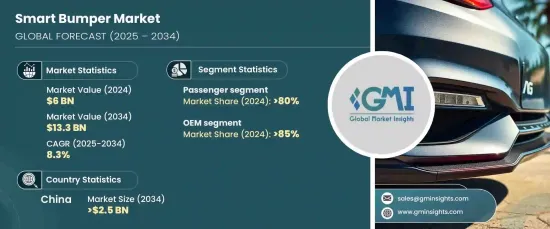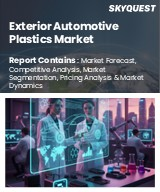
|
시장보고서
상품코드
1665422
스마트 범퍼 시장 기회, 성장 촉진요인, 산업 동향 분석 및 예측(2025-2034년)Smart Bumper Market Opportunity, Growth Drivers, Industry Trend Analysis, and Forecast 2025 - 2034 |
||||||
세계의 스마트범퍼 시장은 2024년 60억 달러로 평가되었습니다. 2025년부터 2034년까지의 CAGR은 8.3%로 예측되어 큰 성장이 예상되고 있습니다.
세계 각국의 정부와 규제기관은 사고감소와 교통안전 향상을 목표로 보다 엄격한 안전기준을 도입하고 있습니다. 센서, 카메라, 충돌 회피 기술을 통합한 스마트 범퍼는 이러한 요구 사항을 충족하는 데 필수적입니다. 이러한 고급 범퍼는 보행자 감지, 주차 지원, 자동 긴급 브레이크 등의 기능과 원활하게 연동하여 승객과 보행자 모두에게 차량을 더욱 안전하게 만듭니다. 이러한 안전성에 대한 관심 증가는 소비자의 의식 증가와 함께 특히 승용차와 고급 차량에서 스마트 범퍼 수요를 촉진하고 있습니다.

자율주행차와 커넥티드카의 개발이 급증하고 있는 것도 스마트 범퍼 시장의 성장을 뒷받침하는 주요 요인입니다. 자동차 산업이 보다 자동화를 향해 가면서 스마트 범퍼는 차량의 안전성과 인텔리전스를 높이는 데 중요한 역할을 하고 있습니다. LiDAR, 레이더, 초음파 센서 등의 기술과 통합된 이러한 범퍼는 실시간 충돌 완화, 장애물 감지, 주변 차량 및 인프라와의 통신에 매우 중요합니다. 자동차 제조업체와 첨단기업이 자율주행 기술에 대한 투자를 늘리면 이러한 첨단 안전 솔루션의 필요성이 더욱 커지고 있습니다. 또한 스마트 범퍼는 커넥티드카의 생태계에 필수적이기 때문에 특히 북미와 유럽에서의 채용이 증가하고 있습니다.
| 시장 범위 | |
|---|---|
| 시작 연도 | 2024년 |
| 예측 연도 | 2025-2034년 |
| 시작 금액 | 60억 달러 |
| 예측 금액 | 133억 달러 |
| CAGR | 8.3% |
시장은 주로 승용차와 상용차의 두 가지 범주로 나뉩니다. 승용차 부문은 시장을 선도하며 2024년 시장 점유율의 80% 이상을 차지했습니다. 이러한 이점은 승용차의 첨단 안전 기능과 운전 편의성 향상에 대한 수요 증가로 인한 것입니다. 자동차 안전에 대한 의식이 높아지고 정부의 규제 강화가 결합되어 스마트 범퍼와 호환되는 ADAS 및 충돌 회피 시스템 등의 기술 채용이 가속화되고 있습니다. 또한, 특히 승용차 분야에서 전기자동차 시장의 급속한 확대가 스마트 범퍼의 채택을 뒷받침하고 있습니다. 자동차 제조업체는 승용차에 맞는 비용 효율적인 안전 솔루션을 제공하기 위해 점점 더 주력하고 있으며, 이 분야가 시장을 선도하고 있습니다.
판매 채널 측면에서 OEM 부문은 지배적이며 2024년에는 시장 점유율의 85% 이상을 차지했습니다. OEM 제조업체는 첨단 안전 기능을 공장 장착 솔루션의 일부로 제공하고 규제 요구 사항과 최첨단 기술에 대한 소비자 수요를 충족하는 이점이 있습니다. 이 제조업체는 스마트 범퍼를 연결 플랫폼, ADAS 및 자율 주행 기능과 같은 차량 시스템에 원활하게 통합할 수 있습니다. 기술 혁신을 위한 자원과 비용을 낮추기 위한 규모의 경제성으로 OEM은 스마트 범퍼 시장에서 큰 이점을 유지하고 있습니다.
중국은 아시아태평양에서 압도적인 지위를 차지하며 2024년 시장 점유율의 60% 이상을 차지했습니다. 이 리더십은 중국의 강력한 자동차 제조 부문과 고급 자동차 기술에 대한 투자 때문입니다. 이 나라에서는 전기차가 급속히 확대되고 스마트 교통과 자율주행 솔루션에 대한 주목이 높아지면서 스마트 범퍼 수요가 더욱 높아지고 있습니다.
목차
제1장 조사 방법과 조사 범위
- 조사 디자인
- 조사 접근
- 데이터 수집 방법
- 기본 추정과 계산
- 기준연도의 산출
- 시장추계의 주요 동향
- 예측 모델
- 1차 조사와 검증
- 1차 정보
- 데이터 마이닝 소스
- 시장 정의
제2장 주요 요약
제3장 업계 인사이트
- 생태계 분석
- 공급자의 상황
- OEM 스마트 범퍼 부품 제조업체
- 애프터마켓 프로바이더
- 유통업체
- 최종 사용자
- 이익률 분석
- 가격 분석
- 특허 상황
- 비용 내역
- 기술과 혁신의 전망
- 주요 뉴스 및 이니셔티브
- 규제 상황
- 영향요인
- 성장 촉진요인
- 자동차의 안전성과 ADAS(첨단 운전자 지원 시스템) 중시의 고조
- 자율주행차와 커넥티드카의 채용 증가
- 보행자와 승객의 안전성에 관한 정부 규제 강화
- 재료와 센서의 통합에 있어서 기술적 진보
- 업계의 잠재적 위험 및 과제
- 기존 범퍼에 비해 높은 비용의 스마트 범퍼 시스템
- 기존 차량 시스템과의 통합과 설계 복잡성
- 성장 촉진요인
- 성장 가능성 분석
- Porter's Five Forces 분석
- PESTEL 분석
제4장 경쟁 구도
- 서론
- 기업 점유율 분석
- 경쟁 포지셔닝 매트릭스
- 전략 전망 매트릭스
제5장 시장 추계·예측 : 유형별(2021-2034년), 10억 달러
- 주요 동향
- 프론트 스마트 범퍼
- 리어 스마트 범퍼
제6장 시장 추계·예측 : 기술별(2021-2034년), 10억 달러
- 주요 동향
- 센서
- 카메라
- LiDAR
- 기타
제7장 시장 추계·예측 : 재료별(2021-2034년), 10억 달러
- 주요 동향
- 플라스틱
- 알루미늄
- 탄소 섬유
- 강철
- 기타
제8장 시장 추계·예측 : 차량별(2021-2032년), 10억 달러
- 주요 동향
- 승용차
- 해치백
- 세단
- SUV차
- 상용차
- 소형 상용차(LCV)
- 대형 상용차(HCV)
제9장 시장 추계·예측 : 판매 채널별(2021-2032년), 10억 달러
- 주요 동향
- OEM
- 애프터마켓
제10장 시장 추계·예측 : 지역별(2021-2034년), 10억 달러
- 주요 동향
- 북미
- 미국
- 캐나다
- 유럽
- 영국
- 독일
- 프랑스
- 스페인
- 이탈리아
- 러시아
- 북유럽
- 아시아태평양
- 중국
- 인도
- 일본
- 한국
- 뉴질랜드
- 동남아시아
- 라틴아메리카
- 브라질
- 멕시코
- 아르헨티나
- 중동 및 아프리카
- UAE
- 남아프리카
- 사우디아라비아
제11장 기업 프로파일
- Aisin Seiki
- Aptiv
- Autoliv
- BorgWarner
- Continental
- Denso
- Forvia
- Hella
- Hyundai Motor
- Koito Manufacturing
- Lear
- Magna International
- NXP Semiconductors
- Panasonic
- Robert Bosch
- Schaeffler
- Tenneco
- Valeo
- Visteon
- ZF Friedrichshafen
The Global Smart Bumper Market is expected to grow significantly, with a projected value of USD 6 billion in 2024 and a CAGR of 8.3% from 2025 to 2034. Governments and regulatory bodies worldwide are introducing more stringent safety standards, aiming to reduce accidents and improve road safety. Smart bumpers, which integrate sensors, cameras, and collision avoidance technologies, are essential in meeting these requirements. These advanced bumpers work seamlessly with features like pedestrian detection, parking assistance, and automatic emergency braking, making vehicles safer for both passengers and pedestrians. This rising focus on safety, along with growing consumer awareness, is driving the demand for smart bumpers, particularly in passenger and luxury vehicles.

The surge in autonomous and connected vehicle development is another key factor propelling the growth of the smart bumper market. As the automotive industry moves towards greater automation, smart bumpers play a critical role in enhancing vehicle safety and intelligence. Integrated with technologies such as LiDAR, radar, and ultrasonic sensors, these bumpers are crucial for real-time collision mitigation, obstacle detection, and communication with surrounding vehicles and infrastructure. The increasing investments in autonomous driving technology by automakers and tech firms further fuel the need for these advanced safety solutions. Additionally, smart bumpers are integral to connected car ecosystems, which increases their adoption, especially in North America and Europe.
| Market Scope | |
|---|---|
| Start Year | 2024 |
| Forecast Year | 2025-2034 |
| Start Value | $6 Billion |
| Forecast Value | $13.3 Billion |
| CAGR | 8.3% |
The market is divided into two primary vehicle categories: passenger and commercial vehicles. The passenger vehicle segment leads the market, accounting for over 80% of the market share in 2024. This dominance is largely due to the rising demand for advanced safety features and improved driving comfort in passenger vehicles. The growing awareness of vehicle safety, combined with stricter government regulations, is accelerating the adoption of technologies like ADAS and collision avoidance systems, which are compatible with smart bumpers. Furthermore, the rapid expansion of the electric vehicle market, especially in the passenger vehicle sector, boosts the adoption of smart bumpers. Automakers are increasingly focusing on providing cost-effective safety solutions tailored for passenger vehicles, making this segment the market leader.
In terms of sales channels, the OEM segment is the dominant player, capturing over 85% of the market share in 2024. OEMs have the advantage of offering advanced safety features as part of factory-installed solutions, meeting regulatory requirements and consumer demand for state-of-the-art technologies. These manufacturers can integrate smart bumpers seamlessly into vehicle systems like connectivity platforms, ADAS, and autonomous driving features. With the resources to innovate and the economies of scale to keep costs low, OEMs maintain a significant edge in the smart bumper market.
China holds a dominant position in the Asia Pacific region, accounting for over 60% of the market share in 2024. This leadership is attributed to China's strong automotive manufacturing sector, along with its investments in advanced vehicle technologies. The country's rapid expansion of electric vehicles and its increasing focus on smart transportation and autonomous driving solutions further enhance the demand for smart bumpers.
Table of Contents
Chapter 1 Methodology & Scope
- 1.1 Research design
- 1.1.1 Research approach
- 1.1.2 Data collection methods
- 1.2 Base estimates and calculations
- 1.2.1 Base year calculation
- 1.2.2 Key trends for market estimates
- 1.3 Forecast model
- 1.4 Primary research & validation
- 1.4.1 Primary sources
- 1.4.2 Data mining sources
- 1.5 Market definitions
Chapter 2 Executive Summary
- 2.1 Industry 3600 synopsis, 2021 - 2034
Chapter 3 Industry Insights
- 3.1 Industry ecosystem analysis
- 3.2 Supplier landscape
- 3.2.1 OEM Smart bumper component manufacturers
- 3.2.2 Aftermarket providers
- 3.2.3 Distributors
- 3.2.4 End users
- 3.3 Profit margin analysis
- 3.4 Pricing analysis
- 3.5 Patent Landscape
- 3.6 Cost Breakdown
- 3.7 Technology & innovation landscape
- 3.8 Key news & initiatives
- 3.9 Regulatory landscape
- 3.10 Impact forces
- 3.10.1 Growth drivers
- 3.10.1.1 Increasing emphasis on vehicle safety and advanced driver-assistance systems (ADAS)
- 3.10.1.2 Rise in autonomous and connected vehicle adoption
- 3.10.1.3 Stricter government regulations on pedestrian and passenger safety
- 3.10.1.4 Technological advancements in materials and sensor integration
- 3.10.2 Industry pitfalls & challenges
- 3.10.2.1 High costs of smart bumper systems compared to traditional bumpers
- 3.10.2.2 Complexity in design and integration with existing vehicle systems
- 3.10.1 Growth drivers
- 3.11 Growth potential analysis
- 3.12 Porter’s analysis
- 3.13 PESTEL analysis
Chapter 4 Competitive Landscape, 2024
- 4.1 Introduction
- 4.2 Company market share analysis
- 4.3 Competitive positioning matrix
- 4.4 Strategic outlook matrix
Chapter 5 Market Estimates & Forecast, By Type, 2021 - 2034 ($Bn, Units)
- 5.1 Key trends
- 5.2 Front smart bumper
- 5.3 Rear smart bumper
Chapter 6 Market Estimates & Forecast, By Technology, 2021 - 2034 ($Bn, Units)
- 6.1 Key trends
- 6.2 Sensors
- 6.3 Cameras
- 6.4 LiDAR
- 6.5 Others
Chapter 7 Market Estimates & Forecast, By Material, 2021 - 2034 ($Bn, Units)
- 7.1 Key trends
- 7.2 Plastic
- 7.3 Aluminum
- 7.4 Carbon fiber
- 7.5 Steel
- 7.6 Others
Chapter 8 Market Estimates & Forecast, By Vehicle, 2021 - 2032 ($Bn, Units)
- 8.1 Key trends
- 8.2 Passenger vehicles
- 8.2.1 Hatchback
- 8.2.2 Sedan
- 8.2.3 SUV
- 8.3 Commercial vehicles
- 8.3.1 Light Commercial Vehicles (LCV)
- 8.3.2 Heavy Commercial Vehicles (HCV)
Chapter 9 Market Estimates & Forecast, By Sales Channel, 2021 - 2032 ($Bn, Units)
- 9.1 Key trends
- 9.2 OEM
- 9.3 Aftermarket
Chapter 10 Market Estimates & Forecast, By Region, 2021 - 2034 ($Bn, Units)
- 10.1 Key trends
- 10.2 North America
- 10.2.1 U.S.
- 10.2.2 Canada
- 10.3 Europe
- 10.3.1 UK
- 10.3.2 Germany
- 10.3.3 France
- 10.3.4 Spain
- 10.3.5 Italy
- 10.3.6 Russia
- 10.3.7 Nordics
- 10.4 Asia Pacific
- 10.4.1 China
- 10.4.2 India
- 10.4.3 Japan
- 10.4.4 South Korea
- 10.4.5 ANZ
- 10.4.6 Southeast Asia
- 10.5 Latin America
- 10.5.1 Brazil
- 10.5.2 Mexico
- 10.5.3 Argentina
- 10.6 MEA
- 10.6.1 UAE
- 10.6.2 South Africa
- 10.6.3 Saudi Arabia
Chapter 11 Company Profiles
- 11.1 Aisin Seiki
- 11.2 Aptiv
- 11.3 Autoliv
- 11.4 BorgWarner
- 11.5 Continental
- 11.6 Denso
- 11.7 Forvia
- 11.8 Hella
- 11.9 Hyundai Motor
- 11.10 Koito Manufacturing
- 11.11 Lear
- 11.12 Magna International
- 11.13 NXP Semiconductors
- 11.14 Panasonic
- 11.15 Robert Bosch
- 11.16 Schaeffler
- 11.17 Tenneco
- 11.18 Valeo
- 11.19 Visteon
- 11.20 ZF Friedrichshafen



















